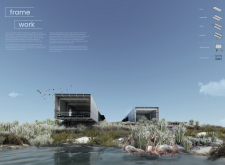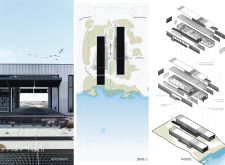5 key facts about this project
The architectural design within the Al Wathba Wetland Reserve demonstrates a careful blend of built form and natural surroundings. It aims to enhance the experience for visitors while protecting the wetland ecosystem. The structure is elevated, allowing for expansive views of the landscape, all while ensuring that the natural environment remains unharmed.
Materiality
The chosen materials reflect a dedication to sustainability and environmental care. Glulam frames create a solid base for the building, offering strength without excessive weight. Prefabricated composite roofs help reduce waste during construction and minimize the impact on the site. Hollow core flooring combines durability with efficiency, while standard metal grating serves practical and visual purposes, allowing water drainage and providing a connection to the environment.
Spatial Organization
A thoughtful arrangement of spaces encourages a variety of visitor interactions. Pathways guide people through distinct areas such as observation platforms, gardens with native plants, and paths dedicated to learning. This layout invites exploration and provides opportunities for deeper engagement with the wetland’s rich ecology. The separation of spaces supports both relaxation and educational experiences.
Environmental Integration
Environmental consideration is central to the design. Open walls and operable louvers ensure that natural air circulates within the structure, enhancing comfort for visitors. Clerestory windows allow light to flood the interior, fostering a connection to the outside. These design choices create an inviting atmosphere that resonates with the natural surroundings.
The architecture carefully maintains the ecological features of the site, allowing native flora and fauna to flourish. Visitors are offered a chance to experience the vibrant life of the wetland, creating a relationship between people and nature. The project illustrates how thoughtful design can enhance understanding and appreciation of the environment.

























































